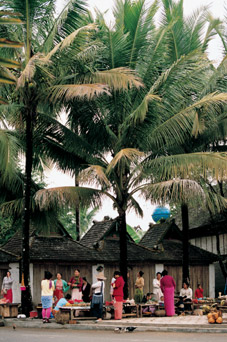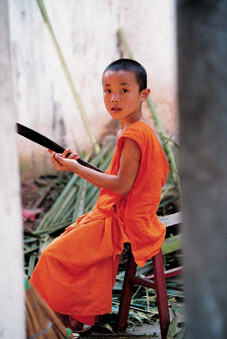
Ganlanba is a beautiful place typical of the customs of the Dai ethnic group and tropical scenery.
The Origin of Its Name
To visit Ganlanba, one has to travel to Jinghong first, the capital city of the Xishuangbanna Dai Autonomous Prefecture in Yunnan Province, and then take an hour's drive downstream along the Lancang River for 37 kilometers.
Ganlanba (Olive Dam), a complex of several villages inhabited by the Dai people, is shaped like an olive and abounds in evergreen plants; hence its name. Viewed from the air, the villages are connected to one another and covered with green trees, while Buddhist pagodas and bamboo tower houses stand out amidst the lush green. Ganlanba is also known as Menghan ("han" means rolling up), and according to a legend, from which the name derives, when Sakyamuni came here to preach Buddhism, his followers laid a cotton cloth on the ground for him to tread on. After he had walked over it, his followers rolled up the cloth.
Ganlanba attracts tourists with its tropical scenery and its Dai ethnic customs. The hot and rainy climate brings Ganlanba abundant products, including a variety of tropical fruits. Delicate bamboo towers dot orchards and bamboo groves, and the Dai women, proportionally shaped and colorfully dressed, make their way elegantly along the paths. When carrying baskets of fruits, the women move their bodies slightly in accordance with the rhythm of the shoulder poles. Myanmar-styled Buddhist temples and pagodas can be found here and there, and it is common to see monks in yellow cassocks traveling around the villages.
Guests in a Dai House
The bamboo houses of the Dai people are a must for visitors to Ganlanba. These houses usually have two stories: The lower story is simply composed of wooden columns, which are used to support the upper story. They look like "Hanging Towers," and are surrounded by spacious courtyards. Local people believe this particular type of structure can help promote air circulation and heat elimination. The upper story is about two meters above the ground, and is made accessible by a wooden ladder.

Whenever a guest comes, a Dai girl, who is usually resting in the courtyard, immediately takes off her shoes and leads the guest to the living room up the stairway. The people of the Dai ethnic group habitually keep their homes clean, so when you visit a Dai house you will need to leave your shoes on the first floor, in order not to dirty the host's living room. By the same token, when you visit a temple, you should leave your shoes outside the halls to show respect.
The walls and floor of the living room are covered with bamboo mats, which make the room cool and comfortable. Because the windows are small, though, the light inside is dim. In the center of the room, there is a small, low bamboo table surrounded by a few bamboo seats. Glutinous-rice tea, for entertaining guests, as well as jade wares and gold and silver ornaments are for sale and are placed on the table. While entertaining the guests with glutinous-rice tea, the Dai girl converses with the guests in sweet, gentle tones. If somebody asks to visit each of the rooms, she would politely tell the visitors it is taboo to enter their bedroom. She will also explain to you that the reason why several generations of a Dai family share a common bedroom, which is only divided by curtains, is because the Dai people believe separating walls causes disharmony. She will also be delighted to tell you that touching the columns in the living room will bring you good luck.
If you stay for a meal, the family's women will be happy to cook dishes of genuine local flavors for you. Most Dai dishes are light, and famous foods include pineapple-flavored rice, crispy deep-fried cowhide, and grass toasted fish. When big fairs are held, the local families offer several tables of wine and food in their living rooms to entertain their relatives and friends from neighboring villages.
Strolling Around Dai Villages
It is a fantastic experience to take a leisurely stroll around the Dai villages. Walking along the paths in the woods, you can enjoy the fragrance of the flowers and view the naive, little children running around. In the temples, you can circle around the towering white pagodas and appreciate their delicate decorations. With the blue sky and white clouds as a backdrop, the golden roofs of the halls become more splendid. Outside the temples, you can also visit squares and souvenir shops and buy tropical fruits. While viewing the skyline of Ganlanba in the glow of the setting sun as you savor a cup of glutinous-rice tea, you feel carefree and joyous.
(China Pictorial September 19, 2003)
|

